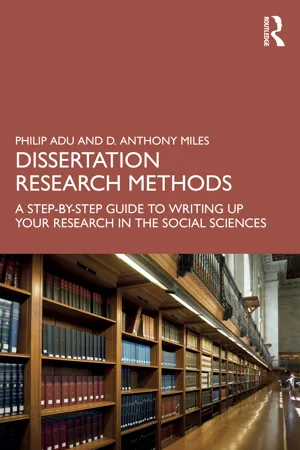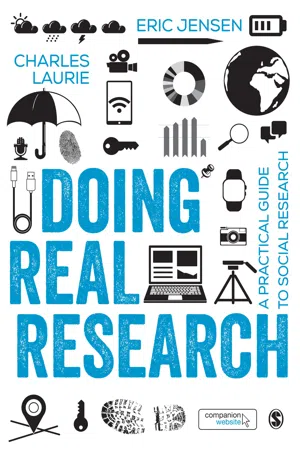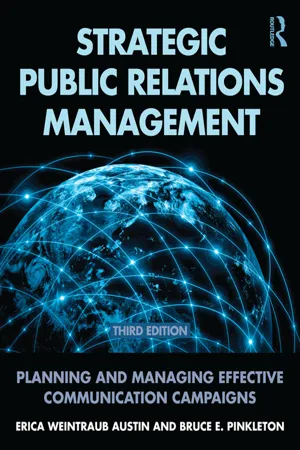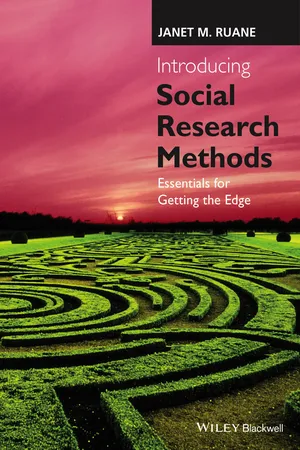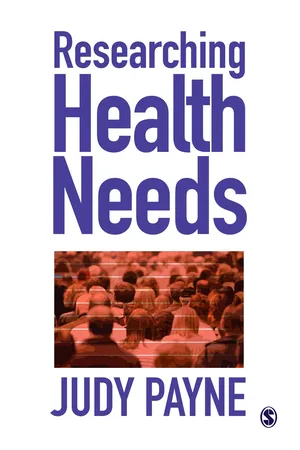Psychology
Snowball Sampling
Snowball sampling is a non-probability sampling technique used to identify and recruit participants through referrals from existing study subjects. This method is often employed when the target population is difficult to access or identify. It involves the initial selection of participants followed by the request for those participants to refer others who meet the study criteria.
Written by Perlego with AI-assistance
Related key terms
Related key terms
1 of 4
Related key terms
1 of 3
12 Key excerpts on "Snowball Sampling"
- eBook - ePub
Dissertation Research Methods
A Step-by-Step Guide to Writing Up Your Research in the Social Sciences
- Philip Adu, D. Anthony Miles(Authors)
- 2023(Publication Date)
- Routledge(Publisher)
Yang & Banamah, 2014 , p. 6).Snowball Sampling
In this sampling procedure, the initial respondents are chosen by probability or non-probability methods, then additional respondents are obtained by information provided by the initial respondents (Acharya et al., 2013 ). Snowball Sampling is a variation of the convenience sampling method. The Snowball Sampling method, which is also known as the “chain method,” is an efficient and cost effective way of accessing people who would otherwise be very difficult to find. Snowball Sampling is a nonrandom sampling method that uses a few cases to help encourage other cases to take part in the study, thereby increasing sample size (Naderifar et al., 2017 ).This approach is most applicable in small populations that are difficult to access due to their closed nature, e.g., secret societies and inaccessible professions (Breweton & Millward, 2001 ; Taherdoost, 2016 ). One clear advantage of Snowball Sampling is that the method is applied when it is difficult to access subjects with the target characteristics. In this non-probability method, the existing study subjects recruit future subjects among their acquaintances. Sampling continues until data saturation. Also in this method, the researcher asks the first few samples, who are usually selected via convenience sampling, if they know anyone with similar views or situations to take part in the research (Naderifar et al., 2017 ). The snowball method not only takes little time but also provides the researcher with the opportunity to communicate better with the participants, as they are acquaintances of the first participant or group of participants, and the first sample is linked to the researcher. One of the greatest advantages of the snowball method is that this type of networking is particularly useful for finding people who are unwilling to reveal their identities (e.g., people who are addicted to illegal substances) (Naderifar et al., 2017 ). A summary of non-probability sampling designs is illustrated in Table 16.2 - eBook - ePub
Doing Real Research
A Practical Guide to Social Research
- Eric Jensen, Charles Laurie(Authors)
- 2016(Publication Date)
- SAGE Publications Ltd(Publisher)
There are two ways to use quotas: proportionally and non-proportionally. Proportional quota sampling involves selecting participants for your sample in proportion to some characteristic of the population as a whole. For example, if 10 per cent of the population you are interested in have no educational qualifications and your sample size is 100 people, then you would sample no more than 10 people without qualifications. Once you have reached this quota, you would stop sampling this category of participant. This method allows you to generate a sample that is on the surface reflective of the distribution of some characteristic across the population (e.g., 51 per cent female, 49 per cent male). However, there is no way to ensure that the sample is representative of the population. For example, while you may use quotas for gender, age and education, there are no further controls beyond these demographic categories. Thus, the particular individuals selected may be highly unrepresentative of the broader demographic category they have been selected to represent.Snowball Sampling
Snowball Sampling is a technique where participants in your research are used to find additional participants. It relies on discovering what Henn et al. (2013, p. 337) describe as a ‘strategically important contact’. This contact introduces you to other contacts that fit the characteristics of your population. This is particularly useful for ‘selecting cases where no obvious lists of [relevant] cases exists’. As Hennink, Hutter and Bailey (2011, p. 100) point out, the technique is ‘particularly suitable for identifying study participants with very specific characteristics, rare experiences or “hidden” population groups who may be difficult to identify with other recruitment methods’, such as intravenous drug users or commercial sex workers. While this technique almost guarantees your sample won’t be representative, it’s used when there may be no other way to access your population other than through personal introductions.Real World Example
Snowball Sampling mineworkers
When researching a project on the experiences of Norwegian oil workers who had worked abroad, Ellen initially found it hard to gather a sample of the population. There was no central record system such as a census, electoral register or health records from which to generate a sample. Scouring the internet for retired oil workers who had written about their own experiences provided only a small number of contacts.Using Snowball Sampling, Ellen’s participant pool mushroomed from this initial set of contacts. From the first few interviews, it became clear that these oil workers had formed a tightly knit group who had kept in touch with each other as they moved around the world. This meant that each participant knew a large number of other former oil workers. Thus, Ellen soon had several hundred people expressing interest in participating in the research. - eBook - ePub
Qualitative Social Research
Contemporary Methods for the Digital Age
- Vivienne Waller, Karen Farquharson, Deborah Dempsey(Authors)
- 2015(Publication Date)
- SAGE Publications Ltd(Publisher)
Named with reference to the image of a rolling snowball increasing in size, Snowball Sampling is where participants are asked to suggest further participants. It is a very common approach in qualitative research. Once a research question is selected and the target population identified, the researcher looks to one or more members of this target population to increase the sample. These key informants should be able and willing to refer the researcher to further participants. Snowball Sampling necessarily only involves people who share a social network, so it is appropriate for research questions where that is likely to be the case. Where this is not the case, the researcher can start more than one snowball with unrelated key informants, enabling the inclusion of people in separate networks. For example, a study might be interested in exploring the workplace experiences of skilled migrants to Australia. After reading the previous research, the researcher might expect that ethnic background and English proficiency might influence migrants’ workplace experiences, so they would then decide to interview people from different ethnic backgrounds. To do this they might start with migrants from several ethnic backgrounds with the expectation that the participants will know others from their own ethnic background. The snowball technique would then lead to participants who came from from a variety of different ethnic backgrounds. If the study had started with just a single migrant from one ethnic background, the sample might not have much ethnic variation.Snowball Sampling is particularly useful for doing research with hard-to-reach populations. Disadvantaged people, people engaged in illicit activities, or stigmatized groups such as injecting drug users, can sometimes only be studied through Snowball Sampling. However, because all the participants are in the same or adjacent social networks, the variation within a sample chosen through Snowball Sampling can be limited. A researcher would need to take this into account in their study design. - Bonita Kolb(Author)
- 2018(Publication Date)
- Routledge(Publisher)
The problem with convenience sampling is that some groups may not be found at a location. This is true if the organization is targeting a specific age group or ethnic community members who rarely attend events. There simply won’t be enough potential participants at any one event to make the effort worthwhile. With groups that are hard to locate, the Snowball Sampling method should be used.Snowball Sampling method
As a snowball rolls down a hill, it becomes larger by gathering more snow. Snowballing as a sampling method works similarly. With this method the researcher first finds a single participant who closely meets the needed profile. This participant then recruits others with similar characteristics that also meet the profile. These participants will then recruit others and so on until enough participants have been found. Technology can now be used to track the invitations and responses, which simplifies the process (Sun 2015).This method is particularly useful when recruiting participants from populations that may not be interested in participating in the research process as they are busy enjoying their holiday. If a garden tour group is staying at a hotel, they are occupied with their schedule. If the marketing researcher converses with one helpful group member and convinces them that the city would like to improve the tour and their participation will assist in this effort, this group member may then convince friends to also be involved.Figure 4.2 Probability sampling will result in a sample of participants that accurately represents the population as a whole. Photo Credit: IamneeWith snowballing, besides choosing the first participant to meet the profile characteristics, the researchers must also choose someone who is trusted and respected by the other members of the group. Once the participants have been referred, the organization will then confirm that they do meet the profile characteristics. The organization will then contact them with the information they need to participate in the research process.There are several ways that snowball recruiting can be done. The first is linear where a relationship is established with one research participant who meets the criteria. This person will then recruit another who will find the third participant, and so on. Another method is to ask more than one potential participant to recruit a goal of several more without concern whether they meet the criteria. Using this method numerous potential participants can then be screened and only those who meet the criteria asked to participate.- eBook - ePub
- Catherine Dawson(Author)
- 2016(Publication Date)
- SAGE Publications Ltd(Publisher)
This is Snowball Sampling. It takes advantage of existing social networks, relying on referrals from initial subjects to generate additional, new subjects (for example, one interviewee will give the researcher details of another person to be interviewed, and so on). This method is used when the study population is small and when description or understanding, rather than generalization, is the goal.Snowball Sampling is useful when it is difficult to find or recruit subjects, perhaps because they are involved in illegal activity or they belong to some type of underground or hidden group, for example. It can make it easier for the researcher to establish contact and be trusted, because they have been introduced by another member of the group. However, this method is subject to bias because friends recommend friends and selection involves deliberate choice. Great care must be taken when choosing the initial contact. Researchers using this method tend to acknowledge bias.Example 3
This is theoretical sampling. Using this method, the emerging theory helps the researcher to choose the sample as the research progresses. Within this sampling procedure the researcher might choose to sample extreme cases that help to explain an emerging theme, or might choose homogeneous samples where people who are alike in some relevant detail (or have similar characteristics) are selected, for example.This method is flexible, creative and cost-effective. However, it is open to sampling bias and the researcher must be aware of this, acknowledging bias as the research progresses. This method can create huge volumes of data that are difficult to analyse: experience and patience can help the project to move forward.Example 4
This is convenience sampling, where subjects are chosen on the basis of convenience (this method can also be termed haphazard or accidental sampling). Researchers use this method because it is inexpensive, informal and practical, having few rules governing how it is used.Convenience sampling is criticized for introducing various types of bias, including sampling, selection and researcher bias (see Activity 15: Recognizing research(er) bias - eBook - ePub
Strategic Public Relations Management
Planning and Managing Effective Communication Campaigns
- Erica Weintraub Austin, Bruce E. Pinkleton(Authors)
- 2015(Publication Date)
- Routledge(Publisher)
Researchers may have no choice but to have to rely on Snowball Sampling when they can locate only a few members of a population. If a social welfare organization wants to learn about the particular difficulties of migrant workers, for example, it might start by interviewing those migrant workers it could locate. After each interview is concluded, interviewers can ask participants to identify other workers who might be willing to participate in the study. Interviewers hope the sample will grow to a desirable size through this process. Research results based on such a sample, however, have little or no generalizability, no matter how large the sample grows. A snowball sample relies on nonrandom methods of selection and there is no way to scientifically determine the degree to which results based on snowball samples represent a population because of this. Nevertheless, the snowball method may be the only way to locate members of hard-to-reach populations such as those who want their status to remain anonymous. As with all projects based on nonprobability samples, managers need to interpret and generalize research findings resulting from snowball samples carefully.Probability Sampling Methods
Researchers generate probability samples using a random-selection process so each member of a population has an equal chance, or probability, of being included in a sample. The use of probability sampling normally allows investigators to make accurate inferences about a population based on information collected from a sample. Even so, investigators’ conclusions about a population are not perfectly accurate even when they use probability sampling. Researchers calculate estimates of the population parameter within a range of possible values at a specific level of probability (you’ll understand this better after reading the chapter). Research findings resulting from probability-based samples normally are highly representative and possess a high degree of generalizability, or external validity. The most common type of probability sample is simple random sampling. Common variations of simple random sampling include systematic sampling, stratified sampling, and cluster sampling. - eBook - ePub
Introducing Social Research Methods
Essentials for Getting the Edge
- Janet M. Ruane(Author)
- 2015(Publication Date)
- Wiley-Blackwell(Publisher)
So, what is the sampling alternative when probability sampling is impossible? The researcher who cannot construct a sampling frame must consider a non-probability sampling technique. As is the case with probability sampling, the researcher has several non-probability sampling options to consider.Convenience Samples
Probably the oldest sampling strategy is the convenience sample (aka accidental sample). As the name implies, this technique builds a sample on the basis of finding convenient or readily available individuals. Those who are selected for the sample are those who are close at hand. If you have ever been asked to fill out a questionnaire in your university student center or as you exited a voting/polling location, you have had first-hand experience with a convenience sample. Clearly, there is an obvious shortcoming to this kind of sampling. Individuals who are not “conveniently” located have no chance of being selected for such samples. For instance, students who never frequent the student center, or voters who were not at the polls at the time surveying was being done, or citizens who voted by mail would never have a chance of making it into the previously described convenience samples. The omission of all but the most conveniently accessed elements in a population greatly undermines the representativeness of a convenience sample.Convenience sample- one that uses readily available (close at hand) elements.Snowball Samples
Snowball Sampling is essentially a sampling strategy built around social networks and referrals. (The technique’s name invokes the image of rolling small snowballs into larger and larger snowballs – i.e. the kind that form the base of a snowman.) The researcher will start the sampling process by contacting a few individuals for inclusion in the sample. These people will then be asked for names of additional people who might be willing to be part of the research project. Snowball Sampling might be a good technique to consider for the tattoo project mentioned above. After making contact and winning the trust of a few “collectors” the researcher would then ask these individuals for names of other collectors. The new names would then be contacted and asked for names of still more collectors. This process is repeated until a satisfactory sample size is achieved. Weston (2004) used this technique to gather a sample for her study of the lesbian and gay community in San Francisco. She used her personal contacts to generate a list of initial potential subjects. Then she asked those folks to suggest names of other potential participants. There is again a clear shortcoming of snowball samples. Individuals who are “loners,” who are not “networked” with others in the research population will likely be excluded from snowball samples. - eBook - ePub
- Jerald Greenberg(Author)
- 2011(Publication Date)
- Routledge(Publisher)
When individuals who meet some relatively rare specification are needed (e.g., individuals who have filed a sexual harassment complaint), it may be particularly useful to prescreen a larger population to identify a subgroup to survey. This is likely to be helpful if the data to be collected are fairly extensive, especially if an interview is to be used. In their study of social processes in workplace bullying, for example, Lewis and Orford (2005) contacted participants for an in-depth interview through a national, UK voluntary telephone helpline for victims of workplace bullying. The coordinator of the helpline provided a list of individuals who met the screening criteria by the researchers (e.g., women having severe problems as targets of bullying in the workplace). The prescreening could be conducted using a very brief questionnaire that includes only enough questions to identify potential participants (e.g., through telephone or through in-person canvassing). This can be done inside an organization by using interoffice mail, e-mail, telephone, or by walking between workstations. Of course, the feasibility of each approach depends on employees’ access to these various forms of office communication.This approach is useful only when the study requires a population of individuals who match a particular specification instead of directly comparing those who fit and those who do not fit. In many cases, however, because researchers are interested in comparing individuals who are engaging in IWB (or who are being targeted by acts of IWB) with those who are not, this approach may have only limited value.Snowball SamplingWith the Snowball Sampling technique, a researcher uses a set of contacts to enlist others to participate in a study. It can be used to access a general sample (e.g., anyone who works) or a sample of people meeting particular specifications (e.g., managers). For example, in their study of mobbing, Zapf, Knorz, and Kulla (1996) recruited participants for the control group by asking people who contacted one of the authors to give the surveys to others. Illustrating the advantages of this approach, Browne (2005) reported on how Snowball Sampling allows access to individuals of a special population (i.e., nonheterosexual women), who otherwise are difficult to identify and convince to participate in research. The initial contacts also might be participants in the study, but they don’t have to be. For example, students in a class can be asked to distribute questionnaires to people fitting a particular requirement, such as those who are employed full time. In their investigation of dynamics of emotional labor, for example, Brotheridge and Lee (2002) asked undergraduate marketing students to give surveys to family members and other acquaintances who interact with customers as part of their jobs. Each participant can be asked, not only to participate, but also to ask others to do so. This can be accomplished easily via e-mail, in which respondents are asked to complete a survey as well as to forward the request to other qualified individuals. - eBook - ePub
Designing Social Research
The Logic of Anticipation
- Norman Blaikie, Jan Priest(Authors)
- 2019(Publication Date)
- Polity(Publisher)
This non-probability method is also known as network, chain referral or reputational sampling. The analogy is of a snowball growing in size as it rolls in the snow. This method has two related uses. In a difficult to identify population, such as intravenous drug users, it may be possible to contact one or two users who can then be asked for contact details of other users, and so on. Another example would be in a study of people who regard themselves as social equals; the respondents’ definitions of social equality can be used to build up a sample. Snowballing can also be used to locate natural social networks, such as friendship networks. Once contact is made with one member of the network, that person can be asked to identify other members and their relationships.Theoretical sampling
Finally, a common sampling method used in some qualitative research is theoretical sampling. When a researcher collects, codes and analyses data in a continuous process, as in grounded theory, decisions about sample size are made progressively. The initial case or cases will be selected according to the theoretical purposes that they serve, and further cases will be added in order to facilitate the development of the emerging theory. As theory development relies on comparison, cases will be added to facilitate this. An important concept in this process is ‘theoretical saturation’. Cases are added until no further insights are obtained; until the researcher considers that nothing new is being discovered. Another grounded theory concept related to sampling is ‘slices of data’, defined as ‘different kinds of data [that] give the analyst different views or vantage points from which to understand a category and to develop its properties’ (Glaser and Strauss 1967: 65). A variety of slices is desirable to stimulate theory development. Just which slices are selected, and how many, is a matter of judgement. An important point about this method of sampling is that any notion of representativeness is irrelevant. - eBook - ePub
Researching Health Needs
A Community-Based Approach
- Judy Payne(Author)
- 1999(Publication Date)
- SAGE Publications Ltd(Publisher)
Because of these limitations, research based on quota samples tends to be treated as less reliable. If you are seeking to convince bureaucrats, politicians and health professionals, your case will be more credible if you have been able to use a random sample. On the other hand, constraints of time, volunteers, or budgets may leave you no option. While random sampling is better, quota sampling, if carefully done, is a good second choice.Snowballing
A snowballing or pyramid sampling method can be used when no population list is available and representativeness is not regarded as important for the investigation. Here, researchers first select people known to them who are appropriate to the study. These people are interviewed and asked to nominate people known to them who fit the selection criteria. These are then interviewed, and so on, until a suitably sized sample is obtained. Thus, in the women with children under 5 example, you would first approach women known to you (or if you knew none, known to some of your friends or colleagues). You would then interview these women and ask them to name other women with children under 5, etc., at each stage making sure that you did not approach previous respondents.This is a very simple and cheap method of obtaining detailed information from people who are not easily identified. However, the resulting sample is likely to be extremely biased towards the particular social groups that you or your first set of respondents belong to. Your findings will, therefore, be of limited generalizability.Purposive sampling
In this method of selection, researchers purposely select people whom they think might contribute useful information. These people are often referred to as key informants or expert witnesses. Here, particular groups of people, such as teachers, police, GPs, councillors, chairpersons of community organizations, shopkeepers etc. are selected. The main disadvantage of this method is that, although it is relatively quick, the views of these people are not necessarily representative of the whole community. Rapid Appraisal, discussed in Chapter 8 - eBook - ePub
Polling America
An Encyclopedia of Public Opinion [2 volumes]
- Richard L. Clark, Kelly N. Foster, Samuel J. Best, Benjamin Radcliff, Richard L. Clark, Kelly N. Foster, Samuel J. Best, Benjamin Radcliff, Richard L. Clark, Kelly N. Foster, Samuel J. Best, Benjamin Radcliff(Authors)
- 2020(Publication Date)
- Greenwood(Publisher)
N th record until a sufficient sample size has been reached. Stratified sampling divides the target population into a number of subpopulations based on a predetermined characteristic and then randomly select a certain number of individuals from each subpopulation. Cluster sampling also divides the target population into subpopulations, but it selects from among subpopulations before sampling within them. Determining the optimal method is typically a function of resource and time constraints and the characteristics of the target population.Nonprobabilistic sampling methods draw samples arbitrarily without a specific probability structure in mind. Individuals are selected because of their availability, geographical proximity, or willingness to participate. Since everyone in the target population does not possess an opportunity of being selected, nonprobabilistic samples cannot be used to compute confidence intervals around the sample estimates that possess some statistical likelihood of containing the true population values. Without such assurances, researchers will be unable to know how well the sample represents the target population. As a result, generalizations beyond the cases studies are no different than educated guesses about the nature of the population.Nonetheless, nonprobabilistic sampling methods can serve other objectives. They can be used to develop hypotheses or refine theories. They can serve to test various instrument designs. When participants are randomly assigned, they can also be used for experimental manipulations to demonstrate the potential effects of particular stimuli.The most commonly used forms of nonprobabilistic sampling are convenience sampling, self-selected sampling, Snowball Sampling, and quota sampling. In convenience sampling, the researcher selects individuals based on their accessibility, such as individuals passing a certain street corner or attending an event. In self-selected samples, individuals volunteer to participate at their convenience. Snowball Sampling uses referrals from individuals who initially agree to participate in a study to generate additional subjects. Quota sampling identifies characteristics germane to the study, such as race, gender, and party identification, and then selects available individuals until these goals are reached. As with probabilistic sampling, the choice of technique is based on resource availability and population characteristics. - eBook - ePub
- Lesley Andres(Author)
- 2012(Publication Date)
- SAGE Publications Ltd(Publisher)
maximum variation by examining important differences and commonalities can focus on the extent to which cases serve to confirm or disconfirm certain phenomena (Miles and Huberman, 1994: 28) or can highlight ‘best’ and ‘worst’ policy strategies or practices (Henry, 1990: 20). An example of this approach would be to employ Esping-Andersen’s (1990, 1999, 2009) welfare regime typology to examine how clusters of countries differ in terms of social welfare policies.Once one or more cases are identified, many survey research sampling strategies may be employed to gather information. For example, in a case study of a large corporation, a stratified random sample of employers may be generated in order to conduct a pen-and-paper survey, and a Snowball Sampling strategy (see below) may be used to identify and carry out face-to-face interviews with the power brokers in the company. A case study design can be strengthened by using a comparative approach.Snowball samples
A snowball research design may be employed when participants are either difficult to locate (e.g., HIV-positive pregnant intravenous drug users living in an inner city) or are part of specialized group of individuals (e.g., members of elite political networks).TEXT BOX 6.3
Ethics Alert!
When employing a snowball sample, be sure to meet the requirements of the appropriate behavioural review boards.Gaining access to such samples often requires some level of insider knowledge. In order to gain access to members of certain populations, an initial site would need to be identified and some sort of initial recruitment strategy employed. For example, recruitment posters could be displayed at safe injection sites. Also, for example, health care or law enforcement staff could be asked to disseminate information about the study. Once one or more respondents who meet the criteria of the study are located, they become recruiters for more respondents by helping to identify others who meet the criteria of the study and who are ‘information rich’ (Miles and Huberman, 1994: 28). However, ethics protocols are key in such studies. It is no longer feasible to ask respondents to provide names and contact information of potential participants as this violates the principles of privacy. Instead, the researcher would provide information to the participant-recruiter who would then pass it on to other potential participants. The latter would contact the researcher directly.
Index pages curate the most relevant extracts from our library of academic textbooks. They’ve been created using an in-house natural language model (NLM), each adding context and meaning to key research topics.
Explore more topic indexes
Explore more topic indexes
1 of 6
Explore more topic indexes
1 of 4
